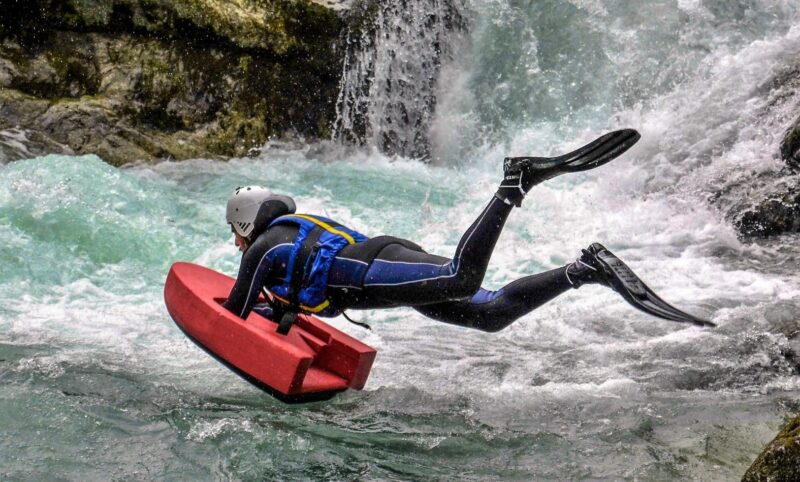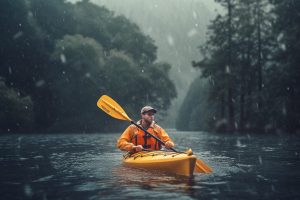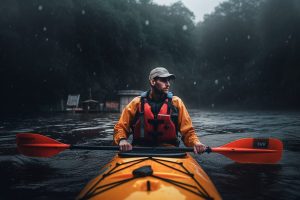Whitewater Kayaking Has Many Risks
The statistics report that over 400,000 individuals annually raft in the United States alone and later. There have been a few serious kayaking injuries reported. Many individuals also report that kayaking is more exhilarating than riding a bike.
However, many individuals need to be made aware of the risks associated with kayaking. Even if you are a kayak enthusiast and kayaking is part of your recreational activities, you need to be aware of the dangers of kayaking and the need for appropriate safety gear and equipment when kayaking.
Risk Of Whitewater
 Although it’s a misconception that kayaking has only one type of danger – the danger of being in a moving body of water and encountering dangerous currents or rapids.
Although it’s a misconception that kayaking has only one type of danger – the danger of being in a moving body of water and encountering dangerous currents or rapids.
Kayaking can be a dangerous adventure if you’re not aware of the possible dangers. It’s important to know all of the hazards associated with kayaking and to know how to avoid any of these hazards.
First, if you are not prepared for kayaking and do not know how to prepare for the great danger that can accompany it, you may face many injuries. If you’re unprepared for kayaking, you could be in for a rough ride and even a potentially life-threatening situation. If you’re not properly prepared, you could even experience an accident. You should also learn about the types of kayaks and life jackets that are appropriate for kayaking.
Whitewater Rafting
The most common kayaking hazard is being caught out in a river or other body of water and unable to stay afloat. Kayaks can get caught in large currents or waves, and if you’re not properly equipped, you could drown. If you are in a kayak, you should wear life jackets. and other appropriate kayaking gear so that you are able to stay afloat if you encounter such a situation. This is one of the many kayaking hazards that is often misunderstood by most kayakers.
If you plan kayaking in colder weather, you should also have a special survival suit specially designed for winter sports. You will protect you from hypothermia and other cold-related dangers. Kayaking in colder waters can also lead to hypothermia, a serious condition.
Dangers Of Whitewater
Kayaking can also involve other hazards that aren’t necessarily kayaking-related. Kayakers who kayak alone can often get separated from their kayaks and lose sight of their kayaks. It is important to always have your kayak with you and to locate your kayak’s paddles, as well as a flag to signal when you’re going out.

In addition, it’s also important to remember that kayaks can often become damaged, causing more problems if they are not properly maintained. If your kayak is not properly maintained, it may be difficult to find it when you are out on the water or to navigate through rapids safely.
You should also carry a rescue float along with you at all times to assist you in case you become separated from your kayak or rafts.
Rafting Safety Tips
Kayaking can also involve hazards such as rapids, which may cause you to go too fast or too slow. When you’re kayaking in a rapid, you should always have someone on hand to assist you and a spotter to call for help. In addition to this, some rapids may be extremely steep, and you may need to use a tow rope to assist you.
Other kayaking hazards can include things such as ice and other debris in the river or the ocean, which may block the kayaks’ kayak line. If you become caught in a kayak, you should also be aware of your body weight and how much force you exert against the kayak to avoid any unexpected injuries to you and/or your kayak. If you become disoriented and cannot determine your direction of travel, or kayak’s position, you should seek help from a spotter.
Kayaking can be very dangerous, but fortunately, there are several ways to minimize its potential dangers. If you plan on taking up kayaking, ensure you have the correct kayaking equipment and fully understand the many kayaking hazards that exist today.
In A Nutshell
In the grand scheme of things, whitewater kayaking, like any thrilling sport, comes with its fair share of risks and potential dangers. From river hazards like strainers and undercut rock walls to the chance of hypothermia in cold water, the level of danger involved can make you get a bloody nose at the hands of your friends flailing around in panic! But let’s not get carried away here – while it’s true that the difficulty of the river can make the danger seem real. The fatality rate is not to be ignored, whitewater kayaking is also a sport that allows you to develop the skills they need to stay safe on the water.

The risk can be significantly reduced with the right safety equipment like a PFD (Personal Flotation Device), a good understanding of river conditions, and the ability to swim to safety if you end up in the water. It’s like a whitewater flow over a rock – it might seem dangerous, but with the right preparation and precautions, it’s a thrill that’s well worth the ride.
So, don’t shy away from the adventure because of the associated risks – instead, take a whitewater kayaking course, understand the risks, and learn to navigate the waters safely. Whitewater kayaking can be dangerous, no doubt about it, but with the right attitude and preparation, it can also be a fun, exhilarating, and relatively safe experience.
Frequently Asked Questions
Is whitewater kayaking considered dangerous?
You betcha! Whitewater kayaking can be dangerous, with potential risks such as river hazards, hypothermia, and even the possibility of getting thrown out of your boat. However, these risks can be significantly mitigated with proper precautions and safety measures.
What are the most common dangers associated with whitewater kayaking?
Well, there are quite a few to take into account. You’ve got everything from changing water levels and unexpected heavy rains to the risk of getting trapped underwater beneath rock walls or cliffs.
Not to mention, areas where the river recirculates can be particularly tricky!
How can I stay safe while whitewater kayaking?
Good question! The key to safe whitewater kayaking is preparation and awareness. Ensure you know the river features, always wear your safety gear, and take a whitewater kayaking course to learn the ropes.
What safety equipment is necessary for whitewater kayaking?
Buckle up! A Personal Flotation Device (PFD) is a must-have, but also consider a helmet, a safety whistle, and a throw rope. And let’s not forget about suitable clothing to avoid hypothermia, especially when kayaking in cold weather.
Is whitewater rafting as dangerous as whitewater kayaking?
Hold your horses! While both sports share similar hazards like high water and river features, the level of danger can vary based on factors like your experience, the river conditions, and whether you’re rafting with a guide or going solo in a kayak.
Can I reduce the risks involved in whitewater kayaking?
Absolutely! The best way to avoid danger is by taking precautions like understanding the risks, learning how to rescue swimmers, and reading the river conditions. Remember, forewarned is forearmed!


